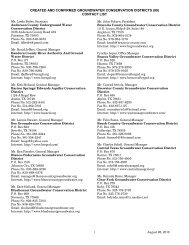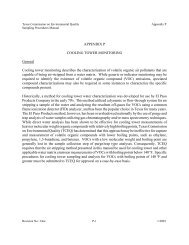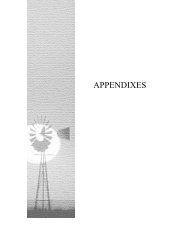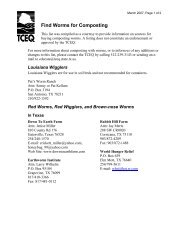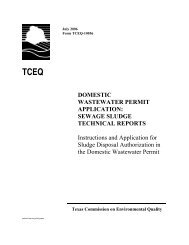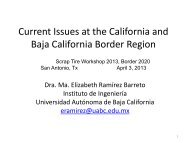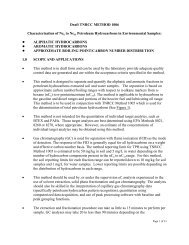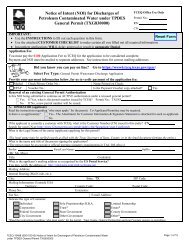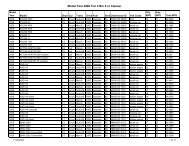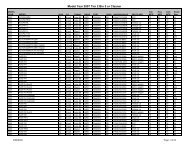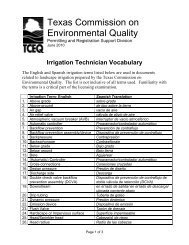savannah ecosystem. On the west, the Broken Red Plains meet the smooth topography <str<strong>on</strong>g>of</str<strong>on</strong>g> the Red Prairie(27h), the broken badlands <str<strong>on</strong>g>of</str<strong>on</strong>g> the easternmost porti<strong>on</strong>s <str<strong>on</strong>g>of</str<strong>on</strong>g> the Caprock Cany<strong>on</strong>s, Badlands and Breaks (26c),recognized as the Pease River Formati<strong>on</strong>, and the more finely dissected, thinly soiled, remnant erosi<strong>on</strong>alridges <str<strong>on</strong>g>of</str<strong>on</strong>g> the Limest<strong>on</strong>e Plains (27j) composed <str<strong>on</strong>g>of</str<strong>on</strong>g> Cretaceous, Permian, and Pennsylvanian limest<strong>on</strong>es.As in Ecoregi<strong>on</strong> 27h, the prairie type is transiti<strong>on</strong>al between tallgrass and shortgrass growth forms. Besidesh<strong>on</strong>ey mesquite, lotebush (Zizyphus obtusifolia), wolfberry (Lycium berlandieri), sand sagebrush (Artemisiafilifolia), yucca (Yucca spp.), and pricklypear cacti (Opuntia spp.) may be mixed with the grasses. Riparianvegetati<strong>on</strong> includes cott<strong>on</strong>wood (Populus spp.), hackberry (Celtis spp.), cedar elm (Ulmus crassifolia), pecan(Carya illinoensis), and little walnut (Juglans microcarpa). In c<strong>on</strong>trast to the predominance <str<strong>on</strong>g>of</str<strong>on</strong>g> cultivati<strong>on</strong> inEcoregi<strong>on</strong> 27h, the Broken Red Plains are used mainly for grazing.Rivers flowing across the Broken Red Plains are meandering and generally turbid except near the outflow<str<strong>on</strong>g>of</str<strong>on</strong>g> regi<strong>on</strong>al dams. River levels follow drought and rainy cycles, but flow may be particularly reduced inriver segments below dams, depending <strong>on</strong> the timing <str<strong>on</strong>g>of</str<strong>on</strong>g> regulated water releases. Particularly during lowflow episodes, rivers and their tributaries may experience problems with high total dissolved solids, lowdissolved oxygen, algal growth, and bacteria due to the proximity <str<strong>on</strong>g>of</str<strong>on</strong>g> oil fields and livestock grazing (RedRiver Authority 2003).The prairie dog town was <strong>on</strong>ce the ecological focus <str<strong>on</strong>g>of</str<strong>on</strong>g> the prairie ecoregi<strong>on</strong>s (26b, 26c, 27h, 27i, 27j);col<strong>on</strong>ies <strong>on</strong>ce covered tens <str<strong>on</strong>g>of</str<strong>on</strong>g> thousands <str<strong>on</strong>g>of</str<strong>on</strong>g> square miles <str<strong>on</strong>g>of</str<strong>on</strong>g> prairie in <str<strong>on</strong>g>Texas</str<strong>on</strong>g> and ranged east as far as thewestern boundary <str<strong>on</strong>g>of</str<strong>on</strong>g> the Western Cross Timbers (29c) (Schmidley 2002). Black-tailed prairie dogs (Cynomysludovicianus) were a plentiful food source for predators, such as the black-footed ferret (Mustela nigripes),rattlesnake (Crotalus spp.), badger (Taxidea taxus), and ferruginous and Swains<strong>on</strong>’s hawks (Buteo regalis,B. swains<strong>on</strong>i). Their extensive system <str<strong>on</strong>g>of</str<strong>on</strong>g> underground burrows housed other animals, such as kit fox (Vulpesvelox macrotis), burrowing owl (Athene cunicularia), and horned lizard (Phrynosoma cornutum). Grasslandbirds, such as the mountain plover (Charadrius m<strong>on</strong>tanus), that today are in serious decline, depended <strong>on</strong> themanicured short grass areas near prairie dog towns for foraging (Doughty 2004). Ranchers saw the prairiedog as a competitor for cattle forage, and pois<strong>on</strong>ing crews used strychnine during the 20 th century to reducethe prairie dog populati<strong>on</strong> by 98% (Schmidley 2002). Many associated species were pois<strong>on</strong>ed as well, andother species dependent <strong>on</strong> the prairie dog for food have disappeared al<strong>on</strong>g with the prairie dog. There is somedebate about whether the reducti<strong>on</strong> in competiti<strong>on</strong> for forage by the eliminati<strong>on</strong> <str<strong>on</strong>g>of</str<strong>on</strong>g> the prairie dog, is balancedtoday by the reducti<strong>on</strong> in forage area caused by the expansi<strong>on</strong> <str<strong>on</strong>g>of</str<strong>on</strong>g> brush which was c<strong>on</strong>trolled in part by theprairie dog (Doughty 2004).Riparian vegetati<strong>on</strong> in Ecoregi<strong>on</strong> 27i can include hackberry,cott<strong>on</strong>wood, elms, and willows. Tree density is sometimes greaterto the east near the Cross Timbers (29), as shown here al<strong>on</strong>g theClear Fork <str<strong>on</strong>g>of</str<strong>on</strong>g> the Brazos River near Ft. Griffin.Photo: <str<strong>on</strong>g>Texas</str<strong>on</strong>g> Archeological Research Laboratory, University <str<strong>on</strong>g>of</str<strong>on</strong>g> <str<strong>on</strong>g>Texas</str<strong>on</strong>g>The burrowing owl uses prairie dog burrowsfor nesting and shelter. Burrowing owlnumbers are seriously declining with thedestructi<strong>on</strong> <str<strong>on</strong>g>of</str<strong>on</strong>g> prairie dog towns as well asthe c<strong>on</strong>versi<strong>on</strong> <str<strong>on</strong>g>of</str<strong>on</strong>g> their south <str<strong>on</strong>g>Texas</str<strong>on</strong>g> winteringground to rowcrop agriculture. Photo: TPWD<str<strong>on</strong>g>Ecoregi<strong>on</strong>s</str<strong>on</strong>g> <str<strong>on</strong>g>of</str<strong>on</strong>g> <str<strong>on</strong>g>Texas</str<strong>on</strong>g> 35
Level IV Ecoregi<strong>on</strong>27i. Broken Red PlainsArea (sq. mi.) 5178Dissected plain, cuesta topography. Streams largely intermittent; larger riversPhysiographymeandering, turbid.Elevati<strong>on</strong> /750-1600 /Local Relief (feet)20-150Quaternary, sandy clay loam and smectitic clay decompositi<strong>on</strong> residuum, calcareousSurficial Geology;clay and red silty clay disintegrati<strong>on</strong> residuum;Bedrock GeologyPermian tan and red shales and sandst<strong>on</strong>es.Mollisols (Argiustolls, Paleustolls), Alfisols (Haplustalfs, Paleustalfs), VertisolsSoil Order (Great Groups)(Haplusterts), Entisols (Ustifluvents)Rolling plains: Bluegrove, Jolly, Weswind, Kamay, Deandale, Hollister, St<strong>on</strong>eburg,Comm<strong>on</strong> Soil SeriesKirkland. Alluvial plains: Tillman, Anoc<strong>on</strong>. Floodplains: Clairem<strong>on</strong>t, Yom<strong>on</strong>t,MangumSoil Temperature /Soil Moisture RegimesThermic /UsticMean Annual Precipitati<strong>on</strong> (in.) 26-32Mean Annual Frost Free Days 210-230Mean Temperature (F)(Jan. min/max; July min/max)28/54;71/96Short and midgrass prairie. Sideoats and blue grama, <str<strong>on</strong>g>Texas</str<strong>on</strong>g> wintergrass,Vegetati<strong>on</strong>buffalograss, sand and little bluestem, vine-mesquite, Wright’s threeawn. Invasiveshrubs: pricklypear, sand sagebrush, wolfberry, mesquite, lotebush. Riparianvegetati<strong>on</strong>: pecan, cedar elm, black willow, little walnut, tobosa grass.Land Cover and Land UseGrassland, shrubland. Grazing for cattle, sheep, and goats. Cropland <str<strong>on</strong>g>of</str<strong>on</strong>g> cott<strong>on</strong>,wheat, and grain sorghum. Oil and gas producti<strong>on</strong>.27j Limest<strong>on</strong>e PlainsThe Limest<strong>on</strong>e Plains ecoregi<strong>on</strong> is composed <str<strong>on</strong>g>of</str<strong>on</strong>g> thin strata <str<strong>on</strong>g>of</str<strong>on</strong>g> Permian-age limest<strong>on</strong>e,sandy limest<strong>on</strong>es, mudst<strong>on</strong>es, and shales, perched <strong>on</strong> top <str<strong>on</strong>g>of</str<strong>on</strong>g> the Permian red beds in anorth-south band between the Red Prairie (27h) and the Broken Red Plains (27i). Theboundaries <str<strong>on</strong>g>of</str<strong>on</strong>g> the Limest<strong>on</strong>e Plains are generalized around groups <str<strong>on</strong>g>of</str<strong>on</strong>g> erosi<strong>on</strong>al remnants<str<strong>on</strong>g>of</str<strong>on</strong>g> Cretaceous, Permian, and Pennsylvanian limest<strong>on</strong>e formati<strong>on</strong>s as indicated <strong>on</strong> geologymaps. The limest<strong>on</strong>e beds are gray and tan in c<strong>on</strong>trast to the red beds <str<strong>on</strong>g>of</str<strong>on</strong>g> the neighboringecoregi<strong>on</strong>s; the rock strata are also embedded with fossilized shells <str<strong>on</strong>g>of</str<strong>on</strong>g> brachiopods and clams (Spearing<str<strong>on</strong>g>199</str<strong>on</strong>g>1). Secti<strong>on</strong>s <str<strong>on</strong>g>of</str<strong>on</strong>g> the Limest<strong>on</strong>e Plains have a rougher topography than the smooth, flat Red Prairie (27h)to the west. Just south <str<strong>on</strong>g>of</str<strong>on</strong>g> Abilene, the west edge <str<strong>on</strong>g>of</str<strong>on</strong>g> the Limest<strong>on</strong>e Plains forms the eastern gateway <str<strong>on</strong>g>of</str<strong>on</strong>g> theCallahan Divide, forming a ridge 120 feet above the Red Prairie (27h) surface. The gap in the ridgeline at thispoint was named Buffalo Gap because herds <str<strong>on</strong>g>of</str<strong>on</strong>g> buffalo were forced to file through the narrow gap during theirmigrati<strong>on</strong>s (Nix 2002).The Limest<strong>on</strong>e Plains are covered by mixed grass prairie <str<strong>on</strong>g>of</str<strong>on</strong>g> little bluestem (Schizachyrium scoparium),yellow Indiangrass (Sorghastrum nutans), and buffalograss (Buchloe dactyloides), with scattered h<strong>on</strong>eymesquite (Prosopis glandulosa). However, upland soils are <str<strong>on</strong>g>of</str<strong>on</strong>g>ten thin, rocky, and droughty in the vicinity<str<strong>on</strong>g>of</str<strong>on</strong>g> limest<strong>on</strong>e outcrops. Drier (or eroded) areas support desert shrubs such as lotebush (Ziziphus obtusifolia),agarita (Mah<strong>on</strong>ia trifoliolata), tree cholla (Opuntia imbricata), and ephedra (Ephedra spp.). And, althoughthe Central Great Plains (27) are typically treeless except in riparian areas, <strong>on</strong> the Cretaceous limest<strong>on</strong>eerosi<strong>on</strong>al remnants <str<strong>on</strong>g>of</str<strong>on</strong>g> Ecoregi<strong>on</strong> 27j, scattered plateau live oak (Quercus fusiformis) and Ashe juniper(Juniperus asheii) grow with mesquite shrub, in transiti<strong>on</strong> to the live oak-mesquite-Ashe juniper woodland<str<strong>on</strong>g>of</str<strong>on</strong>g> the adjacent Edwards Plateau (30). As in some other limest<strong>on</strong>e-based ecoregi<strong>on</strong>s in <str<strong>on</strong>g>Texas</str<strong>on</strong>g> (such as 29d,29e, 30a), land use is dominated by grazing rather than cultivated agriculture. A minor amount <str<strong>on</strong>g>of</str<strong>on</strong>g> wheat orsorghum may be grown in deeper alluvial soils.36<str<strong>on</strong>g>Ecoregi<strong>on</strong>s</str<strong>on</strong>g> <str<strong>on</strong>g>of</str<strong>on</strong>g> <str<strong>on</strong>g>Texas</str<strong>on</strong>g>
- Page 1: Below is an Electronic Version <str
- Page 4 and 5: ECOREGIONS OF TEXAS</strong
- Page 6 and 7: TABLE OF CONTENTSABSTRACT..........
- Page 8 and 9: 2526272526272330293235332430323423
- Page 10 and 11: INTRODUCTIONSpatial frameworks are
- Page 12 and 13: Maps of environmen
- Page 14 and 15: vegetation or small areas o
- Page 16 and 17: the only chipmunk in Texas<
- Page 18 and 19: to the north. There is a high deman
- Page 20 and 21: taller, coarser tobosa grass (Pleur
- Page 22 and 23: the fractured rock. The Bof
- Page 24 and 25: hollows, moving upslope to create c
- Page 26 and 27: The headwater catfish (Ictalurus lu
- Page 28 and 29: streams. Two sand plains streams, C
- Page 30 and 31: Several caliche horizons (calcium c
- Page 32 and 33: winds (Spearing 199</strong
- Page 34 and 35: Geology is an important geographica
- Page 36 and 37: the villages of Pa
- Page 38 and 39: Area (sq. mi.) 5569PhysiographyFlat
- Page 40 and 41: Tableland topography of</st
- Page 42: y the Brazos and Colorado rivers ha
- Page 47 and 48: Post oaks (Quercus stellata) and bl
- Page 49 and 50: Level IV Ecoregion29c. Western Cros
- Page 51 and 52: than the limestone of</stro
- Page 53 and 54: underlying the sandstone. This has
- Page 55 and 56: Since settlement, many wildlife spe
- Page 57 and 58: (Pellaeae spp.), Nuttall’s stonec
- Page 59 and 60: Trinity-Edwards aquifer, discharges
- Page 61 and 62: Edwards Plateau to savanna-like con
- Page 63 and 64: species list, prefers fast moving w
- Page 65 and 66: Level IV Ecoregion31a. Northern Nue
- Page 67 and 68: 31c Texas-Tamaulip
- Page 69 and 70: 31d Rio Grande Floodplain and Terra
- Page 71 and 72: 62shrink when dry and swell when we
- Page 73 and 74: 32b Southern Blackland PrairieThe S
- Page 75 and 76: 33 EAST CENTRAL TE
- Page 77 and 78: and need some patchy distubances an
- Page 79 and 80: 33d Northern Prairie OutliersThe sm
- Page 81 and 82: Level IV Ecoregion33e. Bastrop Lost
- Page 83 and 84: 34a Northern Humid Gulf Coastal Pra
- Page 85 and 86: 34b Southern Subhumid Gulf Coastal
- Page 87 and 88: occasional discontinuous drainage r
- Page 89 and 90: oundary was the ability to match th
- Page 91 and 92: Level IV Ecoregion34f. Lower Rio Gr
- Page 93 and 94:
live oak trees (Quercus virginiana)
- Page 95 and 96:
Shoal grass (Halodule wrightii) mea
- Page 97 and 98:
Upland oak-pine forest in Ecoregion
- Page 99 and 100:
35c Pleistocene Fluvial TerracesThe
- Page 101 and 102:
35f FlatwoodsMostly flat to gently
- Page 103 and 104:
pasture, although some woodland sti
- Page 105 and 106:
invariant definition of</st
- Page 107 and 108:
how many stream sites/watersheds ar
- Page 109 and 110:
commonly believed. Typically, about
- Page 111 and 112:
CONCLUSIONS AND RECOMMENDATIONSThis
- Page 113 and 114:
104Ecoregions <str
- Page 115 and 116:
Biggs, B.J.F., M.J. Duncan, I.G. Jo
- Page 117 and 118:
Diggs, G.M., Jr., and P.C. Schulze.
- Page 119 and 120:
Graves, J. 2002. Texas</str
- Page 121 and 122:
Hunt, C.B. 1967. Physiography <stro
- Page 123 and 124:
Maxwell, T.C. 1979. Avifauna <stron
- Page 125 and 126:
Richmond, G.M., D.L. Weide, and D.W
- Page 127 and 128:
U.S. Department of
- Page 129 and 130:
Woods, A.J., J.M. Omernik, D.R. But
- Page 131 and 132:
Herbaceous Plants(Forbs, Grasses, a
- Page 133 and 134:
Hickory, BlackHickory, WaterHollyHu



